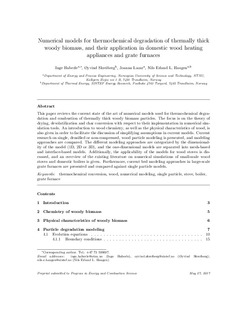| dc.contributor.author | Haberle, Inge | |
| dc.contributor.author | Skreiberg, Øyvind | |
| dc.contributor.author | Lazar, Joanna | |
| dc.contributor.author | Haugen, Nils Erland L | |
| dc.date.accessioned | 2018-02-28T14:22:31Z | |
| dc.date.available | 2018-02-28T14:22:31Z | |
| dc.date.created | 2017-07-20T14:04:35Z | |
| dc.date.issued | 2017 | |
| dc.identifier.citation | Progress in Energy and Combustion Science. 2017, 63 204-252. | nb_NO |
| dc.identifier.issn | 0360-1285 | |
| dc.identifier.uri | http://hdl.handle.net/11250/2487822 | |
| dc.description.abstract | This paper reviews the current state-of-the-art of numerical models used for thermochemical degradation and combustion of thermally thick woody biomass particles. The focus is on the theory of drying, devolatilization and char conversion with respect to their implementation in numerical simulation tools. An introduction to wood chemistry, as well as the physical characteristics of wood, is also given in order to facilitate the discussion of simplifying assumptions in current models. Current research on single, densified or non-compressed, wood particle modeling is presented, and modeling approaches are compared. The different modeling approaches are categorized by the dimensionality of the model (1D, 2D or 3D), and the one-dimensional models are separated into mesh-based and interface-based models. Additionally, the applicability of the models for wood stoves is discussed, and an overview of the existing literature on numerical simulations of small-scale wood stoves and domestic boilers is given. Furthermore, current bed modeling approaches in large-scale grate furnaces are presented and compared against single particle models. | nb_NO |
| dc.language.iso | eng | nb_NO |
| dc.publisher | Elsevier | nb_NO |
| dc.rights | Attribution-NonCommercial-NoDerivatives 4.0 Internasjonal | * |
| dc.rights.uri | http://creativecommons.org/licenses/by-nc-nd/4.0/deed.no | * |
| dc.title | Numerical models for thermochemical degradation of thermally thick woody biomass, and their application in domestic wood heating appliances and grate furnaces | nb_NO |
| dc.type | Journal article | nb_NO |
| dc.type | Peer reviewed | nb_NO |
| dc.description.version | acceptedVersion | nb_NO |
| dc.source.pagenumber | 204-252 | nb_NO |
| dc.source.volume | 63 | nb_NO |
| dc.source.journal | Progress in Energy and Combustion Science | nb_NO |
| dc.identifier.doi | 10.1016/j.pecs.2017.07.004 | |
| dc.identifier.cristin | 1482692 | |
| dc.relation.project | Norges forskningsråd: 267957 | nb_NO |
| dc.relation.project | Norges forskningsråd: 243752 | nb_NO |
| dc.description.localcode | © 2017. This is the authors’ accepted and refereed manuscript to the article. Locked until 12.9.2019 due to copyright restrictions. This manuscript version is made available under the CC-BY-NC-ND 4.0 license http://creativecommons.org/licenses/by-nc-nd/4.0/ | nb_NO |
| cristin.unitcode | 194,64,25,0 | |
| cristin.unitname | Institutt for energi- og prosessteknikk | |
| cristin.ispublished | true | |
| cristin.fulltext | postprint | |
| cristin.qualitycode | 2 | |

